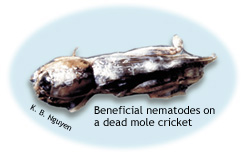Parasite Should Spell Doom For Mole Crickets
by Tom Nordile
A tiny parasite imported from South America by University of Florida researchers
will soon be available commercially to end a 30-year battle with mole crickets,
one of the most troublesome agricultural pests in the Southeast.
Field tests show that the parasite — a worm-like organism known as
the mole cricket nematode — will survive in the region’s climate
and kill mole crickets on a long-term basis, said Grover Smart, professor
of nematology with UF’s Institute of Food and Agricultural Sciences.
The patented organism, expected to be available by fall 2001, will help
farmers, homeowners and golf course managers combat the pest.


The mole cricket, which causes about $94 million in damage to Florida turf
and pastures each year, also affects ornamentals and other crops, he said.
Damage to grasses and seedlings is caused by the insects feeding on roots
and loosening the soil.
Smart said UF experiments with the parasite in north Florida already have
caused a decline in local mole cricket populations.
“We just don’t see a lot of mole crickets any more in areas where
we have tested the parasite,” Smart said. “As the nematode spreads,
it provides highly effective mole cricket control or at least reduces damage
to a level that is acceptable from an economic standpoint.”
Accidentally introduced to the United States from South America more than
75 years ago, mole crickets first became a nuisance to Florida vegetable
growers in the 1930s, but were successfully controlled with arsenic baits
and pesticides such as DDT. The pest became a serious problem in the 1970s
when environmental concerns led to federal restrictions on DDT-type pesticides.
Since then, other pesticides have been used with limited success, Smart
said.
UF researchers first identified the mole cricket nematode in Brazil during
the early 1980s. Smart then isolated a strain of the nematode to achieve
almost 100-percent effectiveness against mole crickets in laboratory experiments
with little or no threat to other U.S. insects. In 1990 he and UF nematologist
K.B. Nguyen identified the nematode as a unique species, Steinernema scapterisci.
UF holds three patents on use of the nematode for pest control.
Once the parasitic nematode enters the body of a mole cricket to mature
and reproduce, it kills the cricket within 48 hours. Young nematodes emerge
from the dead cricket about a week later to seek new hosts. Once infected,
mole crickets can spread the nematode to new areas by flying, crawling or
burrowing, Smart said.
“The mole cricket nematode is a good example of biological control,
using natural predators to control pests without heavy reliance on chemical
pesticides,” Smart said. “Other mole cricket predators live above
ground, but our nematode dwells in the soil where mole crickets do most
of their damage — that’s the real advantage of this parasite.”
MicroBio, a biotech firm owned by Becker Underwood, Inc. in Ames, Iowa,
has obtained exclusive rights through the university to use the nematode
in a commercial product. In late 2001, the company will market the organism
under the Nematac S product name, said Graeme Gowling, MicroBio general
manager.
The product will be marketed to turfgrass and sod farmers as well as home
gardeners. Golf courses are expected to be major users, he said.
Gowling said MicroBio, the world’s largest commercial nematode producer,
is working with a statewide mole cricket task force to help protect millions
of acres of cattle pastureland in Florida.